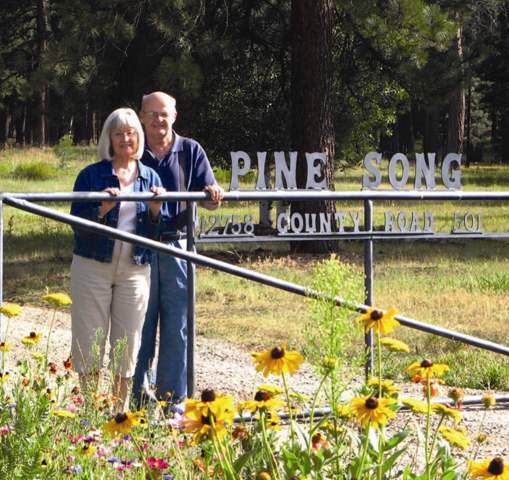Ken and Lois Carpenter
 Bayfield, Colorado
Bayfield, Colorado
In June 2001, a huge wildfire near Durango, Colorado, burned more than 100 square miles of national forest and nearby lands, incinerating 58 homes. Ken and Lois Carpenter—who own, live in and manage a 193-acre pine-spruce forest called Pine Song—watched from a roadblock as the fire reached their property.
“It was the worst thing you could imagine,” recalls Ken Carpenter, “I watched the fire most of the night. The flames were over 200 feet high.”
Pine Song is more than just a piece of property to the Carpenters. When Lois’s parents purchased the tract in 1956, it had only a tarpaper shack and an outhouse— but it was an idyllic spot for outdoor activities, especially fishing. Large rainbow trout and brown trout finned the Pine River, which flows along the edges of Pine Song.
In 1976, when the Carpenters purchased the property from Lois’s parents, the forest had several problems: First, it had been untouched for decades and was densely overgrown. Second, 80 percent of the trees were the same age. And third, noxious weeds had invaded the property. By 1995 property taxes had increased by thousands of dollars partly because the Carpenters had built a home and a guest cabin, along with improving the roads and trails, and partly because Durango had become a resort area.
By the 1990s, the Carpenters needed to take action. “We could either put cattle on the property—but it was all trees and rocks—or start a Tree Farm,” says Carpenter, “I was not a woodsman, but a forester from the Colorado State Forest Service developed a 20-year plan for us, and we entered the forest-agricultural program.”
A New Tree Farm
The plan included thinning the forest, controlling weeds and planting trees. They harvested in 1996, planted 1,800 Ponderosa pine saplings the next year, then repeated the cycle in 1998-1999. They welcomed local fishing guides, Boy Scouts and church and community groups to their property. By the time the Carpenters “ retired” to Pine Song in 2000, they had been members of the American Tree Farm System® for six years.
“It was a godsend that I had those connections,” says Carpenter, “The wildfire totally destroyed 30 acres of our land. It burned to within 100 feet of our house. There was thick smoke, but nevertheless, our property was safe.”
Safe from fire, that is. The damage had just begun. The fire burned off the pine duff and glazed the soil so that rain and snow no longer soaked into the ground. The resulting runoff turned a small creek on the property into a river that cut a huge swath through Pine Song. In addition, a massive landslide dumped tons of boulders and trees into the Pine River, silting the water and killing the fish.The Carpenters relied on the Tree Farmer program, the U.S. Forest Service and their own resources to begin the arduous recovery. They started by cleaning out the dead trees and planting new ones.
"Pine Song"
“The Colorado Tree Farmer program marked what to take down and what could survive,” Carpenter recalls. “Loggers took out the saw-wood, then we bulldozed the rest across Jack Creek to stop the mud. The Forest Service gave us 200 seedlings which we planted with volunteer help.”We later planted 400 2-3 foot trees to jump start the recovery of our forest.
The Carpenters used a $12,000 grant and $6,000 of their own money to clean up Pine River. It took a year to remove the debris from the landslide and recreate the riverbed. “By cleaning up the creek and ravine, we had good water coming through the property again,” says Carpenter. With help from state officials, they were able to restock the river with trout.
Today, Pine Song looks like a park, and it supports one of the best fisheries in southwestern Colorado. “It’s wonderful to have Pine Song and to be able to share it with others,” says Carpenter. “We wouldn’t have it if we weren’t part of the Tree Farm System.”










Comments: